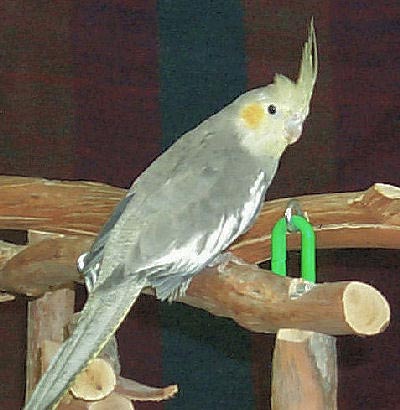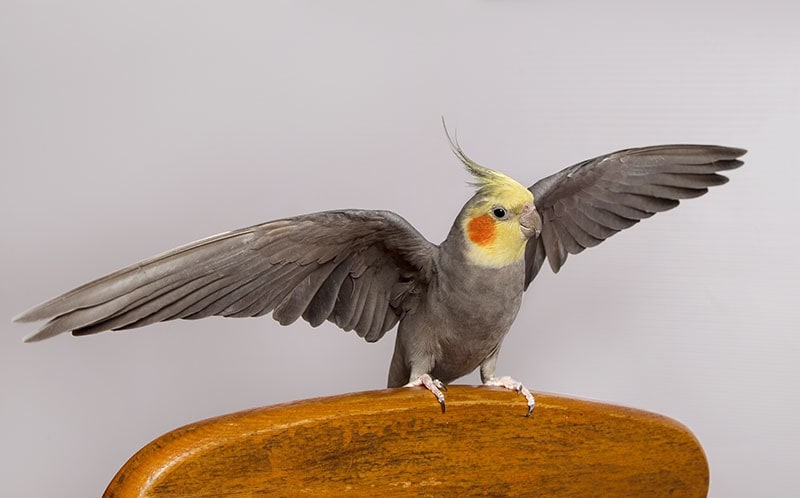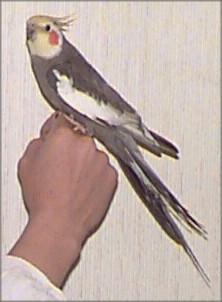
Grey Cockatiels may or may not have red cheek patches, but they ALL have white on their wings!
The Grey Cockatiel is the most common kind of cockatiel. Grey is the natural color of cockatiels in the wild, though there are occasionally some naturally occurring color mutations. These cockatiels are sometimes referred to as the ‘Normal Grey’ Cockatiel or the Wild-Type” Cockatiel.
Cockatiels are probably the most popular of the parrot family with their main competition being the Budgerigar (referred to as the Parakeet in the United States). They make wonderful pet birds because they are are hardy, easily handle changes in their home, and are easy to breed. On top of that, keeping a cockatiel as a pet is easy because they are not noisy parrots and they are comfortable when left alone for long periods of time.
Cockatiels are considered parrots as can be seen by the shape of their beak. They are members of the Cockatoo family which is apparent by their cute little erectile crests. Unlike cockatoos however, they have long tails making up about half of their total length, and giving them more of a parakeet type appearance.
Cockatiel’s evolved as nomadic creatures, surviving in a variety of diverse and rugged habitats. They are constantly on the move, changing locations with the seasonal fluctuations of food and water supplies. This native habitat and their adaptive behavior has made them well suited as pets.
For more information about the care of Cockatiels see:
Guide to a Happy, Healthy Cockatiel
- Kingdom: Animalia
- Phylum: Chordata
- Class: Aves
- Order: Psittaciformes
- Family: Cacatuidae
- Genus: Nymphicus
- Species: hollandicus
Scientific Name
Distribution
Grey cockatiels are found over most of Australia except the coastal areas and most of Tasmania. Tasmania, an island state of Australia, has many of the parrots found in Australia but the cockatiel is not present there. It is thought that though they are one of Australia’s fastest flyers, their flying strength is apparently not sufficient to help them bridge the waterway that separates the island from the Australian mainland.
Description
Cockatiels are considered parrots, as can be seen by the shape of their beak. Cockatiels are probably the most popular of the parrot family. They are closely related to the Cockatoos, and like Cockatoos they are members of the Cacatuidae family.
As members of the Cacatuidae family they too have an erectile crests. This cute little crest will be held erect when they are stimulated and excited, flattened when they are feeling angry, defensive, or submissive, and somewhere in between when they are in their normal ‘hanging out’ state. Unlike the other members of this family, however, they have long tails. The tail makes up about half of their total length and gives them more of a parakeet type appearance.
The Grey Cockatiel is very common pet bird cockatiel. The Grey Cockatiel is not one of the cockatiel mutations. Gray is the natural color of cockatiels in the wild, though there are occasionally some naturally occurring color mutations. Both male and female Grey Cockatiels are primarily gray with white along the outer edge of the wings.
See descriptions of sexual differences for this pet bird cockatiel below, under the breeding cockatiels section.
Size – Weight
These birds get up to 12 inches (30 cm) and weigh 3 to 4 ounces.
Care and feeding
Good sized bird cages are a must for good cockatiel care. A roomy cockatiel cage is required unless the bird is to be let out for extended periods. Many birds can spend most of their time on a playpen or parrot perch. Bird food consists of a variety of sprouts, seeds, nuts, fruits, vegetables, and commercial pellets.
See About Cockatiels: Care and Feeding for more information.
Social Behaviors
Cockatiels travel in flocks in the wild and this influences cockatiel behavior in captivity. Their social ‘flock’ disposition along with their native habitat makes them well suited as pets. They are hardy, adapt easily to change, and are easy to breed. A big plus is that cockatiels are not noisy and can be left alone for long periods of time. They make a very loving and devoted pet if bonded properly.
For taming cockatiels and cockatiel training, see About Cockatiels: Handling and Training.
Activities
Common bird activities for cockatiels, they like to climb and play. Cockatiel bird care includes providing lots of bird toys and excercise. Give them plenty of time outside the cage if possible, a playpen works well for this. Many cockatiels can learn to talk and whistle, especially the males.
See About Cockatiels: Activities for more information.
Breeding/Reproduction
Cockatiel breeding can be a very rewarding experience. Cockatiels will readily nest provided they have a nest box and some material to construct the nest from. They lay one egg every other day until they have laid about 5 eggs. The incubation period is 17 – 22 days. After hatching the young birds will open their eyes at 9 days of age.
|
This is a good time to start hand feeding if you don’t want to incubate the eggs yourself. Incubation and raising the chicks yourself requires dedication since the baby cockatiels will need feedings every two hours for the first couple of weeks. Likewise, you can pull them from the nest earlier than 9 days, but with greater risk to the chick and greater effort on your part with frequent feedings. After about 18 days the orange cheek patch will appear on the babies. At about 30 days they will look like adult birds, and will fledge at about 35 days of age.
For more information on cockatiel breeding, see About Cockatiels: Breeding/Reproduction.
Sexual differences
There are a lot of opinions about how to sex these birds, but with many of the color varieties they are usually they are just indicators, and not certain ways to tell. A Grey Cockatiel can usually be visually sexed at about six months of age. A mature grey male will have a yellow or white face while the female’s face will be grey or a lighter grey. Males also generally have a darker and more distinct orange spot on the cheek than females, but not always. All juvenile Grey Cockatiels have barring on the underside of the tail. This barring is lost with the male’s first molt but is retained by the female.
“Loki” (seen to the right) is a male by this criteria. Loki is one of the oldest (and maybe the prettiest) cockatiels that we know of. He (or she?) is at least 23 years old and looks very healthy! “Loki” is the name of the Viking God of mischief. Do you think the owner is trying to say something about this sweet innocent little bird?
Potential Problems
The cockatiel health is easy to maintain as these are very hardy birds, but for all pet birds there are potential problems For optimum bird health care for your cockatiel, it is good to know what signs of illness to be aware of.
For information about cockatiel health, see About Cockatiels: Problems.
Availability
The Grey Cockatiel is one of the most common cockatiels for sale. It is readily available and affordable. There are also lots of different color mutations readily available including lutino, pied, pearl, cinnamon, and white-faced varieties.
Featured Image Credit: Jolanta Beinarovica, Shutterstock

